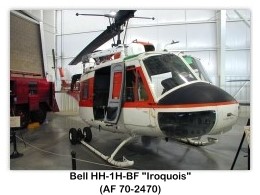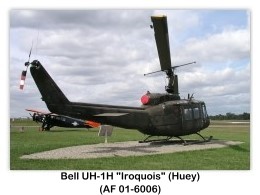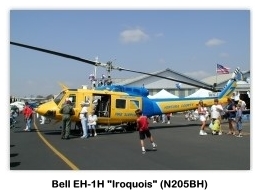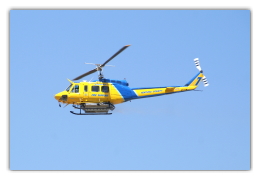
| ||||
|---|---|---|---|---|
 |
 |
 |
 |
 |



























| ||||
|---|---|---|---|---|
 |
 |
 |
 |
 |


























Bell UH-1H Iroquois (Huey)
United States — Six-seat Utility Helicopter
Archive Photos 1,2
Bell UH-1H Iroquois Huey (AF 70-2470) on display (11/20/2001) at the Hill Aerospace Museum, Hill AFB, Roy, Utah (Photo by John Shupek copyright ©2001 Skytamer Images)

Bell UH-1H Iroquois Huey (AF 01-6006) on display (9/25/2003) at the Yankee Air Museum, Belleville, Michigan (Photos by John Shupek)

Bell EH-1H Iroquois Huey (N205BM, AF 68-16272) on display (7/4/2000) at the 2000 Santa Paula Airshow, Santa Paula, California (Photos by John Shupek)

Bell EH-1H Iroquois Huey (N205BM, AF 68-16272) on display (8/19/2006) at the 2006 Camarillo Air Show, Camarillo, California (Photos by John Shupek)

Bell UH-1H Iroquois (AF 65-10126) on display (2/16/2004) at the National Air and Space Museum Steven F. Udvar-Hazy Center, Chantilly, Virginia (Photo by Jim Hough)

Overview 3
The Bell Helicopter UH-1 Iroquois, commonly (or officially in the U.S. Marine Corps) known as the Huey, is a multipurpose military helicopter, famous for its use in the Vietnam War. The Bell UH-1 Iroquois was developed from 1955 US Army trials with the Bell Model 204. The initial designation of HU-1 (helicopter utility) led to its nickname, Huey. The aircraft was first used by the military in 1959 and went into tri-service production in 1962 as the Bell UH-1 Iroquois. The last were produced in 1976 with more than 16,000 made in total, of which about 7,000 saw use during the Vietnam War. In Vietnam, 2,202 Huey pilots were killed and approximately 2,500 aircraft were lost, roughly half to combat and the rest to operational accidents.
Design and Development 3
Earlier helicopters had been powered by piston engines. By the early 1950s, however, turbine engines were being used in many fixed-wing aircraft and aircraft designers began to consider using them for rotary-wing use. Turbines, though expensive to build, were long-lived, durable, and extremely light for their power output in comparison to piston-powered engines.
The first Bell helicopter to use a turbine engine was a modified Model 47 (designated the XH-13F), first flown in October 1954. In 1955, anxious to obtain a powerful medical evacuation helicopter, the U.S. Army awarded Bell a contract to develop the next generation turbine-powered helicopter, designated the XH-40 (Bell company designation was the Model 204). The first XH-40 flew on 22 October 1956. Two more prototypes were built in 1957, and six YH-40 prototypes were tested in 1958.
Bell believed the YH-40 was ideal for troop transport and cargo carrying as well as the medevac role, a view soon adopted by the Army, who found the pre-production aircraft so much better in service than previous piston-powered helicopters they soon ordered more of them.
The HU-1A (later redesignated the UH-1A) was the first turbine-equipped U.S. helicopter to go into production, and production models first entered service with the 101st Airborne Division at Fort Campbell, Kentucky, the 82nd Airborne Division and the 57th Medical Detachment. Although they were intended for evaluation only, the Army quickly pressed them into operational service and Hueys with the 57th Medical Detachment arrived in Vietnam in March 1962.
The helicopter was originally designated the HU-1A, which is where it received its nickname Huey, a reference so popular that Bell started putting the Huey name on the anti-torque pedals. The official U.S. Army designation Iroquois (Army helicopters are traditionally given Native American names) was almost never used in practice.
Aircraft Markings 3
Bell UH-1Hs used for ferrying VIP’s into Panmunjom in the DMZ area between North and South Korea used three 12" wide Yellow stripes vertically over the fuselage. It signified unarmed aircraft carrying UNCMAC members.
U.S. Navy UH-1Ns serving as "organic to the ship" helicopters on LP and LH amphibious war vessels were painted dark grey with national insignia, much like the paint scheme carried on the Kaman SH-2 Seasprite throughout the 1980s. Each ship had one helicopter, and the ship’s name was often carried on the cabin doors.
Operational History 3
Service in Vietnam
The Bell UH-1 has long become a symbol of US involvement in Southeast Asia in general and Vietnam in particular, and as a result of that conflict, has become one of the worlD’s most recognized helicopters. In Vietnam primary missions included general support, air assault, cargo transport, aeromedical evacuation, search and rescue, electronic warfare, and later, ground attack. During the conflict, the craft was upgraded, notably to a larger version based on the Model 205. This version was initially designated the UH-1D and flew operationally from 1963.
Helicopters played an integral part in the U.S military’s land and air operations. Here UH-1D’s airlift members of the 2nd Battalion, 14th Infantry Regiment from the Filhol Rubber Plantation area to a new staging area, in 1966. During service in the Vietnam War, the UH-1 was used for various purposes and various terms for each task abounded. UH-1s tasked with a ground attack or armed escort role were outfitted with rocket launchers, grenade launchers, and machine guns. These gunship UH-1s were commonly referred to as Hogs if they carried rockets, and Cobras if they had guns. UH-1s tasked for troop transport were often called Slicks due to an absence of weapons pods. Slicks did have door gunners, but were generally employed in the troop transport and medevac roles. In the US Navy and USMC the gunships were referred to as Sharks and troop transport aircraft as Dolphins.
Bell UH-1s also flew hunter-killer teams with observation helicopters, namely the Bell OH-58A Kiowa and the Hughes OH-6 Cayuse. Towards the end of the conflict, the UH-1 was tested with TOW missiles, and two UH-1B helicopters equipped with the XM26 Armament Subsystem were deployed to help counter the 1972 Easter Invasion.
Bell UH-1 troop transports were designated by Blue teams, hence the nickname for troops carried in by these Hueys as the Blues. The reconnaissance or observation teams were White teams. The attack ships were called Red teams. Over the duration of the conflict the tactics used by the military evolved and teams were mixed for more effective results. Purple teams with one or two Blue slicks dropping off the troops, while a Red attack team provided protection until the troops could defend themselves. Another highly effective team was the Pink Recon/Attack team, which offered the capability of carrying out assaults upon areas where the enemy was known to be present but could not be pinpointed.
During the course of the war, the UH-1 went through several upgrades. The UH-1A, UH-1B, and UH-1C models (short fuselage, Bell 204) and the UH-1D and UH-1H models (stretched-fuselage, Bell 205) each had improved performance and load-carrying capabilities. The UH-1B and UH-1C performed the gunship and some of the transport duties until 1967, when the new AH-1 Cobra arrived on the scene. The newer Cobra, a purpose-built attack helicopter based on the UH-1 was faster, sleeker, harder to hit, and could carry more ordnance. The increasing intensity and sophistication of NVA anti-aircraft defenses made continued use of gunships based on the UH-1 impractical, and after Vietnam the Cobra was adopted as the Army’s main attack helicopter. Devotees of the UH-1 in the gunship role cite its ability to act as an impromptu dustoff if the need arose, as well as the superior observational capabilities of the larger Huey cockpit, which allowed return fire from door gunners to the rear and sides of the aircraft.
During the war 3,305 UH-1’s were destroyed. In total, 5,086 helicopters were destroyed out of 11,827 documented in service.
USAF
In October 1965, the USAF 20th Special Operations Squadron was formed at Tan Son Nhut Air Base in South Vietnam, equipped initially with Sikorsky CH-3C helicopters. By June 1967 the UH-1F and UH-1P were also added to the unit’s inventory, and by the end of the year the entire unit had shifted from Tan Son Nhut to Nakhon Phanom Royal Thai Air Force Base. On 1 August 1968, the unit was redesignated the 20th Special Operations Squadron. The 20th’s UH-1s were known as the Green Hornets, stemming from their color, a primarily green two-tone camouflage (green and tan) was carried, and radio call-sign hornet. The main role of these helicopters were to insert and extract reconnaissance teams, provide cover for such operations, conduct psychological warfare, and other support roles for covert operations especially in Laos during the so-called Secret War.
El Salvador
During its civil war El Salvador received about 80 UH-1Hs and 24 UH-1Ms from the US, as part of the aid to fight the guerrillas between 1979 and 1992. These helicopters were heavily engaged in combat, supporting the army in fighting guerrillas throughout the country. As a result many were shot down. After the war only 20 UH-1H and 14 UH-1M survived, most of them scrapped a few years later.
These helicopters were operated by El Salvador Air Force, being at its time the biggest and most experienced combat helicopter force in Central and South America, fighting during 10 years and being trained by US Army in tactics developed during the Vietnam war. Gunship UH-1M helicopters used by El Salvador were modified to carry bombs instead of rocket pods. UH-1Hs were also used as improvised bombers.
During the battle of Nahr el-Bared camp in North Lebanon, the Lebanese army, lacking fixed-wing aircraft, modified the UH-1H allowing it to carry 500 lb (227 kg) Mk. 82 dumb bombs to strike militant positions. Each Huey was equipped on each side with special mounts engineered by the Lebanese army, to carry the high explosive bombs.
Current service
The US Army phased out the UH-1 Huey with the introduction of the UH-60 Black Hawk, although the Army UH-1 Residual Fleet has around 700 UH-1’s that were supposed to be retained until 2015. Army support for the craft was intended to end in 2004.
The US Marine Corps still relies on the UH-1N variant and is beginning to introduce the latest variant, the UH-1Y Venom.
The United States Air Force employs UH-1N Hueys to fulfill its ICBM mission, providing a utility helicopter for transport between bases such as Francis E. Warren AFB and Malmstrom AFB to missile launch sites in Montana, Wyoming, Nebraska, and Colorado. Additionally, the UH-1N is used by the 36th Rescue Flight (36 RQF) at Fairchild AFB, near Spokane, WA for conducting Search-and-Rescue (SAR) and medical evacuation missions.
The UH-1 has been widely exported and remains in front line service in a number of countries.
Variant Overview 3
U.S. Military Variants
Other Military Variants
List of UH-1 Iroquois Operators 3
Specifications (UH-1D) 3
General Characteristics
Performance
Armament (Variable, but may include a combination of:)
Popular Culture 3
The image of American troops disembarking from a Huey has become iconic of the Vietnam War, and can be seen in many films, video games and television shows on the subject, as well as more modern settings. The Bell UH-1 Huey is seen in many films about the Vietnam war, including The Green Berets, Platoon, Hamburger Hill, Apocalypse Now, Casualties of War, and Born on the Fourth of July. It is prominently featured in We Were Soldiers as the main helicopter used by the U.S. Cavalry in the Battle of Ia Drang.
References